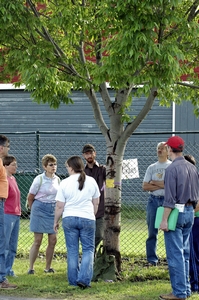Subscriptions
Menu
Advertisements
DEC warns of emerald ash borer threat$
6/8/2011 |
By Patsy Nicosia |

You will probably never see an emerald ash borer.
But you could end up footing the bill for the mess the half-inch long beetle leaves behind here—a bill that in New York Statewide could run into the millions.
As part of an effort to spread awareness of the pest’s potential impact on municipalities and homeowners, Cobleskill’s Village Street Trees Committee, Landis Arboretum Director Fred Breglia, local Cooperative Extension and Soil & Water staff and others met with DEC’s Erin Brady during the first-ever Emerald Ash Borer Awareness Week for a first-hand look at the invasive beetle.
There’s no way to stop the emerald ash borer, Ms. Brady said, but by slowing its spread, communities will be in a better position to deal with its financial impact.
“The biggest concern is public safety,” explained CCE’s David Cox, though there will also be impacts on the forestry and even recreation industries.
Once infested, an ash tree will live only 2-4 years before starting to rot and break apart; in Michigan, removing those dead trees over-ran the state budget by 10 times.
Though there are preventative measures homeowners can take, they’re expensive, Mr. Cox said, and need to be repeated every 2-3 years.
Cobleskill is fortunate, he said, in that there aren’t many ash trees here—mountain ash trees with their familiar orange berries aren’t hurt by the slender, green beetle.
The most visible of Cobleskill ashes are located along the fence at the Fairgrounds and the SUNY Cobleskill walkway between the computer parking lot and Curtis Mott Hall.
As a way to create awareness, Ms. Brady helped the local volunteers tag the Fairgrounds ash trees.
The next step, Mr. Cox said, will be to create a county task force that will inventory the ash population and assess the removal cost should—when?--the emerald ash borer arrives; already, it’s in nearby Greene and Ulster Counties.
Anyone interested in serving on the task force can contact Mr. Cox at 234-4303 or by email at dgc23@cornell.edu.
According to DEC, the emerald ash borer has already killed tens of millions of ash trees in the United States and hundreds of millions more are at risk.
Ms. Brady said the pest is most often moved in firewood; DEC is already restricting the use of carry-in wood at its campgrounds.
Some 10,000 purple prism emerald ash borer traps have been hung at the borders of quarantined areas, she added, and several are visible along a number of local roads.
“But full eradication isn’t possible,” Ms. Brady cautioned.
“Our only hope is to slow them down and contain them so municipalities can deal with the costs.
Signs of an emerald ash borer infestation include: Thinning at the tree’s crown, woodpecker damage—they’re after the larvae inside—D-shaped exit holes made as the adults leave, S-shaped feeding tunnels just under the bark, and sucker sprouts growing from the base of the tree.
Ms. Brady said DEC is hoping “citizen scientists” will report suspected infestations.
A form for doing that is available online at dec.ny.gov/animals/72136.html.
You can also call DEC’s toll-free Firewood and Invasive Insects Hotline, (866) 640-0652 or email firewood@gw.dec.state.ny.us, or contact the local Cooperative Extension, 234-4303.
• • •
Questions CEE suggests asking:
• How many ash trees are in my community?
• How will these trees be treated or removed?
• Who will replant them?
• How will the emerald ash borer affect my community’s budget?
• What will my town look like after the emerald ash borer arrives?









